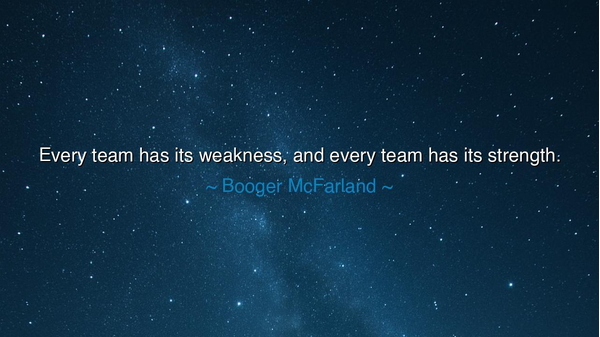
Every team has its weakness, and every team has its strength.






The former athlete and commentator Booger McFarland uttered a truth as timeless as the art of war itself: “Every team has its weakness, and every team has its strength.” At first glance, these words seem simple, born of the sporting field. Yet beneath them lies a wisdom as old as the struggles of tribes, nations, and civilizations. For no gathering of people, whether in sport, in battle, or in life’s daily labors, is without flaw. And yet, equally true, no gathering is without power. To know this balance is to see clearly; to embrace it is to lead wisely.
The acknowledgment of weakness is not a curse, but a path to humility. Every team, no matter how skilled, bears within it some fracture, some shortcoming, some blind spot. To deny this is folly, for the enemy will always find it. Yet to face it with honesty is strength in disguise, for it is in knowing our frailty that we prepare ourselves for endurance. Weakness is the teacher that whispers, “Guard here, for you are vulnerable.”
On the other hand, every team possesses its own strength — some quality, visible or hidden, that makes it formidable. Strength may not always be found in raw power; it may be in unity, in spirit, in strategy, or in the courage to rise again after defeat. To recognize strength is to find confidence, to know that though one’s weaknesses may be exploited, one is never without weapons of their own. Strength is the shield and sword of the collective, forged by effort, trust, and shared sacrifice.
History is rich with examples. Consider the Battle of Thermopylae, where the Spartans and their allies faced the vast Persian army. Their weakness was clear: they were vastly outnumbered, doomed by sheer size of opposition. Yet their strength lay in discipline, terrain, and indomitable spirit. Though they fell, their resistance inspired Greece to unite and ultimately drive back the invader. Here, we see the truth of McFarland’s words: no team is wholly weak, no team is wholly strong — the story is written in how they wield both.
The wisdom of this teaching extends beyond war and sport, into the smallest circles of human life. A family, a workplace, a circle of friends — all are teams. Each bears imperfections, each shines with gifts. The wise learn not to despair over weakness, nor to boast blindly of strength. Instead, they weave the two together, covering the frailties of one with the gifts of another, so that together they stand as a whole stronger than the sum of its parts.
The lesson is clear: do not seek a perfect team, for such a thing does not exist. Instead, seek the awareness to recognize both weakness and strength. Leaders must learn to protect their team where it falters, and to unleash it where it excels. Members must not hide their flaws nor hoard their gifts, but offer both openly, so that the team may stand balanced.
In your own life, embrace this truth. In your family, see where others stumble, and be the hand that steadies them. In your work, see where your companions excel, and let their light lead the way. Do not curse the weaknesses, for they are the soil in which loyalty and trust are grown. Do not idolize strength alone, for it can become pride. Instead, honor both, and walk the path of balance.
Thus, let McFarland’s words echo like a drum of wisdom: “Every team has its weakness, and every team has its strength.” Do not despair at the first, nor grow arrogant in the second. For the true art of the team is to unite both into harmony, and in that harmony lies victory — not only on the field, but in the greater arena of life itself.






AAdministratorAdministrator
Welcome, honored guests. Please leave a comment, we will respond soon